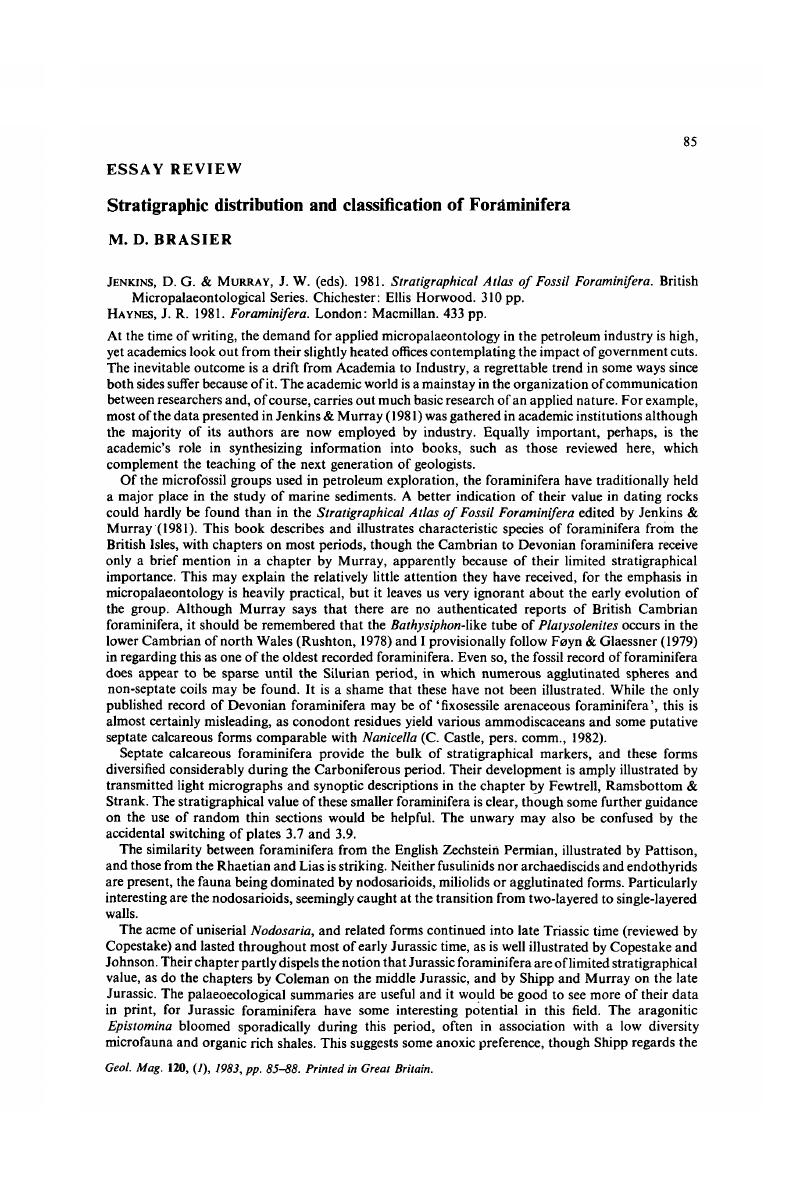No CrossRef data available.
Article contents
Stratigraphic distribution and classification of Foraminifera
Published online by Cambridge University Press: 01 May 2009
Abstract
An abstract is not available for this content so a preview has been provided. Please use the Get access link above for information on how to access this content.

- Type
- Essay Review
- Information
- Copyright
- Copyright © Cambridge University Press 1983
References
REFERENCES
Barnard, T. 1960. Some species of Lenticulina and associated genera from the Lias of England. Micropaleontology 6, 41–55.CrossRefGoogle Scholar
Brasier, M. D. 1982. Architecture and evolution of the foraminiferid test: a theoretical approach. In Aspects of Micropalaeontology (ed. Banner, F. T. and Lord, A. R.). London: George Allen & Unwin. (In the Press.)Google Scholar
Brotzen, F. 1963. Evolutionary trends in certain calcareous foraminifera on the Palaeozoic-Mesozoic boundary. In Evolutionary Trends in Foraminifera (ed. von Koenigswald, G. H. R. et al.), pp. 66–78. Amsterdam: Elsevier.Google Scholar
Brouwer, J. 1969. Foraminiferal assemblages from the Lias of N. W. Europe. Verh. K. ned. Akad. Wet. 25, 1–64.Google Scholar
Cushman, J. A. 1948. Foraminifera, their Classification and Economic Use, 4th ed. Cambridge, Mass.: Harvard University Press.CrossRefGoogle Scholar
Føyn, S. & Glaessner, M. F. 1979. Platysolenites, other animal fossils, and the Precambrian-Cambrian transition in Norway. Norsk geol. Tidsskr. 59, 25–46.Google Scholar
Galloway, J. J. 1933. A Manual of Foraminifera. Bloomington, Indiana: Principia Press.Google Scholar
Hohenegger, J. & Piller, W. 1975. Wandstrukturen und Grossgleiderung der Foraminiferen. Sber. öst. Akad. Wiss. Abt. 1, 184, 67–96.Google Scholar
Hohenegger, J. & Piller, W. 1977. Die stellung der Involutinidae Butschli und Spirillinidae Reuss im System der Foraminiferen. Neues Jb. Geöl. Palaont. Mh. 7, 407–18.Google Scholar
Loeblich, A. R. & Tappan, H. 1964. Protista 2. Sarcodina, chiefly ‘Thecamoebians’ and Foraminiferida. In Treatise on Invertebrate Paleontology part C, 2 vols (ed. Moore, R. C.). Geological Society of America and University of Kansas Press.Google Scholar
Loeblich, A. R. & Tappan, H. 1974. Recent advances in the classification of the Foraminiferida. In Foraminfera, vol. 1. (ed. Hedley, R. H. and Adams, C. G.), pp. 1–53. London: Academic Press.Google Scholar
Pokorny, V. 1965. Principles of Zoological Micropalaeontology, vols 1 and 2 (ed. Neale, J. W.). Oxford: Pergamon Press.Google Scholar
Rushton, A. W. A. 1978. Description of the macrofossils from the Dolwen Formation. Bull. geol. Surv. G.B. 61, 46–8.Google Scholar
Tappan, H. 1976. Systematics and the species concept in benthonic foraminiferal taxonomy. Spec. Publ. Marit. Sediments 1 A, 301–13.Google Scholar
Wood, A. 1949. The structure of the wall of the test in the Foraminifera; its value in classification. Q. Jl. geol. Soc., Lond. 104, 229–55.CrossRefGoogle Scholar




